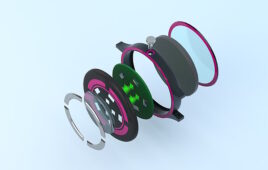~ Article courtesy of Master Bond

Did you know that 100% solid epoxies typically contain no Volatile organic compounds (VOCs)? They’re ideal for applications in enclosed spaces and those with large bonding or coating areas.
Volatile organic compounds (VOCs) are compounds that have high vapor pressure and low water solubility. Many VOCs are human-made chemicals used and produced in the manufacturing of paints, pharmaceuticals, and refrigerants.
VOCs are typically industrial solvents or by-products produced by chlorination in water treatment, such as chloroform. They’re common ground-water contaminants and often components of petroleum-based products, hydraulic fluids, paint thinners, and cleaning agents. They’re also emitted by an array of products numbering in the thousands.
A few examples of products that contain VOCs include paints and lacquers, industrial adhesives, paint strippers, cleaning supplies, pesticides, building materials and furnishings, office equipment (such as copiers and printers), correction fluids and carbonless copy paper, graphics materials, permanent markers, and photographic solutions.
Concentrations of many VOCs are consistently higher indoors (up to 10 times higher) than outdoors.
Health effects of VOCs
The extent and nature of the health effects of VOCs will depend on several factors, including the level of exposure and the duration and frequency of exposure.
Some of the symptoms that can occur after exposure include:
- Eye and respiratory tract irritation
- Headache
- Nausea and dizziness
- Visual disorders
- Memory impairment
Some VOCs can also cause cancer in animals (based on toxicological studies).
VOC regulations
Clean Air Act standards, Environmental Protection Agency (EPA) VOC standards, and regulations pertaining to the use of solvents in various industries are as follows.
- National Emission Standards for Hazardous Air Pollutants (NESHAP)
- New Source Performance Standards (NSPS)
- Control Techniques Guidelines (CTG)
- Alternative Control Techniques (ACT)
- National Volatile Organic Compound Emission Standards – 183(e) VOC Rule
The EPA recommends that states adopt requirements consistent with the presumptive Reasonably Available Control Technology or RACT (ground-level VOC). These measures are only a recommendation, and states may develop their own RACT requirements on a case-by-case basis, based on the economic and technical circumstances of individual sources.
Currently, no federal laws or regulations preclude states from requiring more stringent controls than those recommended as RACT. Some states might require additional control to meet the national ambient air quality standards (NAAQS) for ozone in some areas.
VOCs are an extremely important consideration in industries such as aerospace, medical, electronics, oil and chemical processing, and industrial OEMs.
The key to ensuring that VOCs are mitigated is to select compounds that contain no solvents or high levels of VOCs. This will limit the VOC from the start and reduce the outgassing of VOCs over time at a device level.
Reformulation to lower VOC content would be beneficial from health and safety aspects and require less VOC control measure equipment.
Epoxies that are 100% solid typically contain zero volatile organic compounds, making them ideal for applications in enclosed spaces and those with extensive bonding or coating areas.
 Resources
Resources
Guidelines from the Environmental Protection Agency (EPA):
- Volatile Organic Compounds’ Impact on Indoor Air Quality: AirQualityVOCs
- “Control of Volatile Organic Compound Emissions from Coating Operations at Aerospace Manufacturing and Rework Operations”: ControlVOCs









Tell Us What You Think!